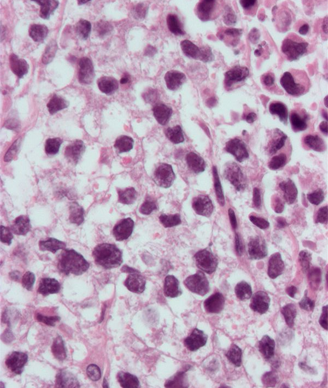Surveillance Yields Excellent Long-Term Outcomes in Stage I Testicular Cancer
Active surveillance is effective and yields good outcomes in patients with clinical stage I testicular cancer who underwent orchiectomy.
Micrograph of a testicular seminoma; copyright Nephron 2009.

Active surveillance is effective and yields good outcomes in patients with clinical stage I testicular cancer (CSI-TC) who underwent orchiectomy, according to a pair of studies published in the December and January issues of the Journal of Clinical Oncology.
“Most patients with CSI-TC are cured by orchiectomy alone,” wrote study authors led by Christian Kollmannsberger, MD, of the University of British Columbia in Vancouver. “With highly effective chemotherapy providing a safety net, ultimate cure rates approach 100% irrespective of the postorchiectomy strategy employed.” Thus, diminishing morbidities associated with treatment is a primary concern.
In Kollmannsberger and colleagues’ study, data from 2,483 CSI-TC patients was analyzed retrospectively (1,139 nonseminoma and 1,344 seminoma patients). All underwent orchiectomy, and then were treated with active surveillance. A total of 19% of the nonseminoma and 13% of the seminoma patients experienced a relapse. In the nonseminoma group, 90% of relapses occurred within the first 2 years after orchiectomy; in the seminoma group, 92% occurred within the first 3 years.
Even with those relapse rates, survival from the disease was exceptionally high. Three nonseminoma patients (0.3%) died of disease, while three patients in both groups died of treatment-related causes. The 5-year disease-specific survival rate was 99.7%.
In the other study, led by Gedske Daugaard, MD, of Rigshospitalet in Copenhagen, Denmark, researchers observed 1,226 patients with stage I nonseminoma germ cell cancer over a long period, from 1984 through 2007. Again, a surveillance management program yielded very good outcomes.
In this cohort, the relapse rate was 30.6% at 5 years, with 80% occurring within the first year. The presence of vascular invasion along with embryonal carcinoma and rete testis invasion in the testicular primary identified a subgroup of patients with much higher risk of relapse, at 50%; the three factors were present in about 5% of the patients. Those patients who did not fall into that category had a relapse risk of only 12%. The disease-specific survival rate in this group was 99.1% at 15 years.
“The aim of the surveillance strategy is to cure patients with the lowest possible treatment intensity,” wrote Daugaard and colleagues. “We find that a surveillance policy… is a safe approach associated with an excellent cure rate and an overall low treatment burden.” Risk-adapted treatment is now possible as well, with the identification of the higher risk subgroup.
Kollmannsberger et al also concluded that a surveillance strategy is now well proven for these patients. They wrote also that relapses beyond 3 years are rare, on the order of 1%, and that CT/MRI scanning beyond 3 years is unlikely to yield substantial benefit. “The main focus of imaging-based surveillance is the first 2 to 3 years after orchiectomy.”